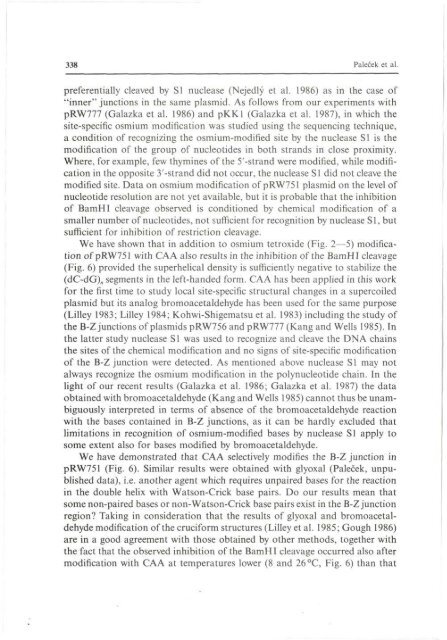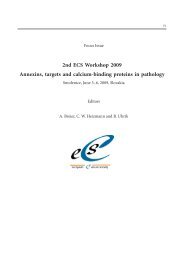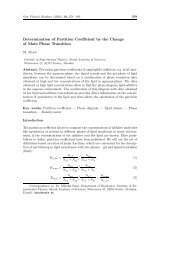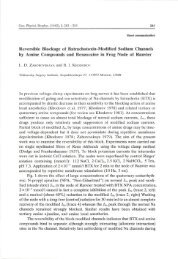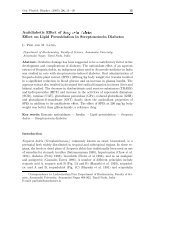Inhibition of Restriction Endonuclease Cleavage due to ... - Gpb.sav.sk
Inhibition of Restriction Endonuclease Cleavage due to ... - Gpb.sav.sk
Inhibition of Restriction Endonuclease Cleavage due to ... - Gpb.sav.sk
Create successful ePaper yourself
Turn your PDF publications into a flip-book with our unique Google optimized e-Paper software.
338 Paleček et al.preferentially cleaved by SI nuclease (Nejedlý et al. 1986) as in the case <strong>of</strong>"inner" junctions in the same plasmid. As follows from our experiments withpRW777 (Galazka et al. 1986) and pKKl (Galazka et al. 1987), in which thesite-specific osmium modification was studied using the sequencing technique,a condition <strong>of</strong> recognizing the osmium-modified site by the nuclease S1 is themodification <strong>of</strong> the group <strong>of</strong> nucleotides in both strands in close proximity.Where, for example, few thymines <strong>of</strong> the 5'-strand were modified, while modificationin the opposite 3'-strand did not occur, the nuclease SI did not cleave themodified site. Data on osmium modification <strong>of</strong> pRW751 plasmid on the level <strong>of</strong>nucleotide resolution are not yet available, but it is probable that the inhibition<strong>of</strong> BamHI cleavage observed is conditioned by chemical modification <strong>of</strong> asmaller number <strong>of</strong> nucleotides, not sufficient for recognition by nuclease S1, butsufficient for inhibition <strong>of</strong> restriction cleavage.We have shown that in addition <strong>to</strong> osmium tetroxide (Fig. 2—5) modification<strong>of</strong> pRW751 with CAA also results in the inhibition <strong>of</strong> the BamHI cleavage(Fig. 6) provided the superhelical density is sufficiently negative <strong>to</strong> stabilize the(dC-dG)„ segments in the left-handed form. CAA has been applied in this workfor the first time <strong>to</strong> study local site-specific structural changes in a supercoiledplasmid but its analog bromoacetaldehyde has been used for the same purpose(Lilley 1983; Lilley 1984; Kohwi-Shigematsu et al. 1983) including the study <strong>of</strong>the B-Z junctions <strong>of</strong> plasmids pRW756 and pRW777 (Kang and Wells 1985). Inthe latter study nuclease SI was used <strong>to</strong> recognize and cleave the DNA chainsthe sites <strong>of</strong> the chemical modification and no signs <strong>of</strong> site-specific modification<strong>of</strong> the B-Z junction were detected. As mentioned above nuclease SI may notalways recognize the osmium modification in the polynucleotide chain. In thelight <strong>of</strong> our recent results (Galazka et al. 1986; Galazka et al. 1987) the dataobtained with bromoacetaldehyde (Kang and Wells 1985) cannot thus be unambiguouslyinterpreted in terms <strong>of</strong> absence <strong>of</strong> the bromoacetaldehyde reactionwith the bases contained in B-Z junctions, as it can be hardly excluded thatlimitations in recognition <strong>of</strong> osmium-modified bases by nuclease SI apply <strong>to</strong>some extent also for bases modified by bromoacetaldehyde.We have demonstrated that CAA selectively modifies the B-Z junction inpRW751 (Fig. 6). Similar results were obtained with glyoxal (Paleček, unpublisheddata), i.e. another agent which requires unpaired bases for the reactionin the double helix with Watson-Crick base pairs. Do our results mean thatsome non-paired bases or non-Watson-Crick base pairs exist in the B-Z junctionregion? Taking in consideration that the results <strong>of</strong> glyoxal and bromoacetaldehydemodification <strong>of</strong> the cruciform structures (Lilley et al. 1985; Gough 1986)are in a good agreement with those obtained by other methods, <strong>to</strong>gether withthe fact that the observed inhibition <strong>of</strong> the BamH I cleavage occurred also aftermodification with CAA at temperatures lower (8 and 26 °C, Fig. 6) than that


